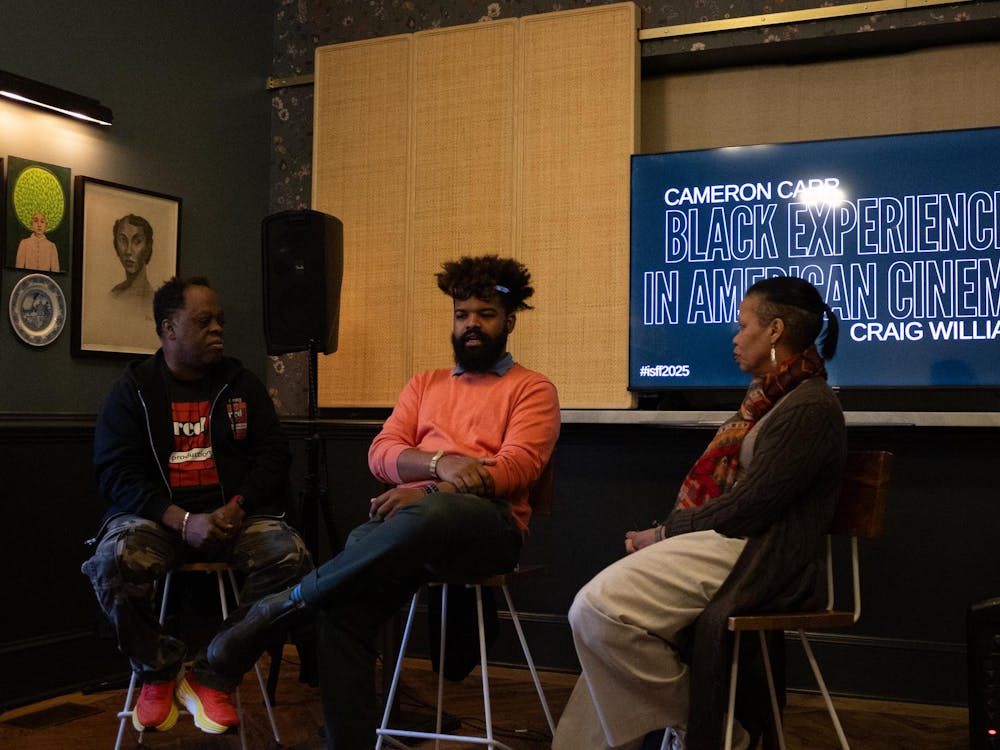The past year in feature films has been one for the record books. The big screen has produced a host of history-making moments, from Jordan Peele becoming the first African-American writer/director to surpass $100 million at the box office to Rachel Morrison becoming the first woman ever to be nominated for an Academy Award for Cinematography.
For a culture so obsessed with shortening everything into a 280-character social media soundbite, public discourse has centralized around feature-length films and largely ignored the art form of the animated short. The Animation Show of Shows aims to change that.
The Animation Show of Shows is put forth annually by Acme Filmworks Inc., a company that was founded in 1990 by film producer Ron Diamond. The intent of Acme Filmworks Inc. is to produce and highlight visual content from artists, creators and animators looking to explore unique forms of storytelling. In 1998, Diamond created The Animation Show of Shows to showcase the best animated short films of all time to industry professionals. This year, Diamond’s curated picks are available to the Charlottesville community as part of the Virginia Film Festival. The 16 animated shorts were made available to the public during an exclusive showing Feb. 20 at the Violet Crown Cinema on the Downtown Mall.
The films for this year’s release are deeply resonant, given the current political climate in which the United States is embroiled. These short films stand out, reflecting a society unsure of its future and role in global politics. There are a few main themes that carry throughout the 16 shorts, the large ones being humankind’s relationship with nature, oppression and liberation and the meaning of life. Overall, the shorts seek to explore the role each living organism plays in the grand scheme of the universe.
Despite these broadly serious themes, there is humor and beauty to be found in the films as well. That is the true beauty of The Animation Show of Shows — the show is a blend of humor, art, history and philosophy, equal parts educational and entertaining, a must see for anyone seeking to be a film buff or an informed citizen.
Below is a brief synopsis of each of the 16 films featured in The Animation Show of Shows in order of appearance.
“Can You Do It”
Directed by French director Quentin Baillieux, “Can You Do It” is an artfully produced social commentary. The animation is done through Harlem Renaissance-style art, featuring cool tones and geometric interpretations of the human form. The animation style seems to serve as a symbol reflective of the subject matter of the piece, which revolves around African-American trailblazers and simultaneously introduces the idea the mere existence is a form of resistance. The only sound in the film is the song “Can You Do It” by Charles X, which hammers home the titular question in a powerful and poignant manner.
“Tiny Big”
“Tiny Big,” by Belgian director Lia Bertels, is an abstract exploration of the desire of humans to find a purpose in life. The film shows various artistic interpretation of humans seeking love, money and entertainment and begs the resonant question of “What do we lose when we are in constant chase?”
“Next Door”
“Next Door,” from American director Pete Docter, comments on the way in which childhood wonder dissipates into strict routine and rigidity as humans grow older. The film revolves around a square old man who just wants to watch his TV and his round-cheeked neighbor, a little girl with a larger-than-life imagination. The short is touching and genuine and calls to mind a sort of harmony found through exploration of the imagination.
“The Alan Dimension”
“The Alan Dimension,” from Jac Clinch of the U.K., comes as a well-timed moment of levity a fourth of the way through the entire program. Alan is by all accounts a simple man, a retired accountant living in suburbia with his wife Wendy — except that Alan is a psychic. He becomes obsessed with his pre-cognizant visions to his wife’s chagrin, and lets his life completely devolve as he attempts to prove his powers. “The Alan Dimension” is pure fun, a silly romp with romance grounded in reality.
“Beautiful like Elsewhere”
“Beautiful like Elsewhere,” from Canadian director Elise Simard, is a hauntingly gorgeous production exploring the cycle of life and the temporary nature of all things. “Can beauty be found in destruction?” the film asks. The film’s intent is summed up in one arresting line at the very beginning — “I tell you someone will remember us in the future.”
“Hangman”
“Hangman,” from Paul Julian and Les Goldman of the United States, is fascinating in equal parts for its subject matter and its historical context. “Hangman” is a restored animated short from the 1960s public school curriculum and is arguably the most politically relevant to today. The film depicts a town under siege from the Hangman, who built a giant gallows in the town square and is hanging innocent people left and right. The film is a social commentary on complicity in one’s own destruction, emphasized by the haunting words, “And we gave him way,” from the narrator.
“The Battle of San Romano”
“The Battle of San Romano,” by Swiss director Georges Schwizgebel, brings to life the painting of the same name by Paolo Uccello. The chaotic and jumbled animation style is deeply resonant, seeming to speak to the endless cycle of violence in war. It’s impossible for a viewer to focus on any given form or character, perhaps referencing the anonymity of war. Blood splatter is animated to morph into fresh soldiers, and the audience is left with one question — what are these people dying for?
“Gokurosama”
“Gokurosama” is a group effort from French directors Clémentine Frère, Aurore Gal, Yukiko Meignien, Anna Mertz, Robin Migliorelli and Romain Salvini. The film is another uplifting, funny moment in the show as a whole. Set in a Japanese shopping center, the short revolves around an elderly shopkeeper and her young employee as they prepare to open for the day. But their plans are thwarted when the shopkeeper throws her back out. The employee doesn’t know how to help — until a benevolent man in a teddy bear suit steps in.
“Dear Basketball”
“Dear Basketball,” from American director Glen Keane, is currently a nominee for the Academy Award for Best Animated Short. The film revolves around and is narrated by basketball legend Kobe Bryant and is a new interpretation of a modern romance. Written as though Bryant is reading a letter to the game, the short is a love story between a man and the sport that gave him everything.
“Island”
“Island,” by German directors Max Mörtl and Robert Löbel, is an adorably educational claymation that explores the synchronicity found in the natural world. The short personifies all natural elements, from rocks to volcanos to trees, bringing nature to life in a musically driven narrative.
“Unsatisfying”
“Unsatisfying,” from Parallel Studio in France, is just that. Literally. The film is a compilation of things that are objectively unsatisfying — a basketball circling the rim and falling off, a soup spoon sliding and submerging into a bowl of soup, a line of dominos that stop falling halfway through. The retro-style animation set to a soundtrack of dramatic violins is funny and frustrating at the same time.
“The Burden”
“The Burden,” from Swedish director Niki Lindroth von Bahr, is kind of like a melancholy fever dream. The short is a musical exploring the lives of various night shift workers, but all of the characters appear to be lifelike animal puppets. The hotel concierge is a singing fish, the McDonald’s janitors are tap-dancing mice, the telemarketers are singing monkeys and the night shift employee at the grocery door is a dog doing spoken word. Despite the absurdity of it all, “The Burden” is a powerful film that looks at survival from a new lens — a negative one, at that. Does the necessity to make money to live hamper one’s ability to find happiness? “The Burden” says yes.
“Les Abeilles Domestiques” (“Domestic Bees”)
“Les Abeilles Domestiques,” from Canada’s Alexanne Desrosiers, is an abstract representation of the interconnectivity of the human experience, an exploration of the shared experiences everyone has in a lifetime. The film stakes the claim that everyone is just bumbling around, following the same patterns of joy and heartbreak, embarrassment and love, ultimately reaching the conclusion that we are all just bored animals looking for companionship.
“Our Wonderful Nature: The Common Chameleon”
“Our Wonderful Nature: The Common Chameleon,” from German director Tomer Eshed, is a laugh-out-loud mockumentary about a chameleon that can’t stop eating — even when the bugs he’s going after are twice his size. It’s a hilarious and cute short film with “The Very Hungry Caterpillar” vibes that is a joy for audiences of all ages.
“Casino”
“Casino,” from Canada’s Steven Woloshen, is the most abstract short. The narration is told through colorful flashes of brushstrokes and curved lines. It’s chaos, but with a pattern that gives an impression of inebriation to the viewer. In this short, the items in the casino are the main characters. The playing cards dance, the dice argue and the blackjack table seems to grin.
“Everything”
The final short in the program comes from American director David OReilly. The animation style is choppy and is part of a Minecraft-style video game. It almost feels as though the viewer is moving around the world, clicking on different objects and organisms to zoom in on. Based on the work of late philosopher Alan Watts, the short explores the interconnectedness of everything in the universe and the way that perspective defines reality.







